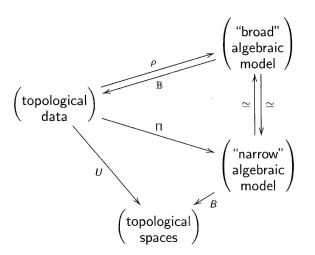Since "Pursuing Stacks" was "written in English in response to a correspondence in English" I feel I ought to explain my own current position in relation to the Grothendieck Programme, and also to that of Whitehead, many of whose results and methods were a kind of guiding light. In particular, his theorem on free crossed modules proved in "Combinatorial Homotopy II" (CHII) led us (Phil Higgins and I) away from attempting to define higher homotopy groupoids for spaces, but instead for pairs of spaces in dimension 2, and then for filtered spaces. This suggested analogous results in discussions with Jean-Louis Loday.
A general picture of the methodology is covered by the following "generic" diagram of categories and functors:
with the following properties:
- $\rho, \Pi$ are homotopically defined, correspond under the vertical equivalence, and preserve certain colimits;
- $\rho \mathbb B$ is naturally equivalent to $1$;
- There is a natural transformation $1 \to \mathbb B \rho$ preserving some homotopical information.
The purpose of the final part of 1. is to allow some calculations, and in particular some description of certain "free" objects. 3. is little vague, but is useful to bear in mind. Finally, $B= U \mathbb B$, where $U$ is the forgetful functor, is a kind of classifying space for the algebraic model.
We have two examples of this situation.
A. topological data = filtered spaces, broad algebraic data = (strict) cubical $\omega$-groupoids with connections, narrow algebraic data = crossed complexes. This is explained in detail in the book Nonabelian Algebraic Topology, which develops a lot of the work in CHII, and does not reach other parts.
B, topological data = $n$-cubes of pointed spaces, broad algebraic data = cat$^n$-groups, narrow algebraic data = crossed $n$-cubes of groups. A survey of this may found in the expository article "Computing homotopy types using crossed N-cubes of groups""Computing homotopy types using crossed N-cubes of groups", with references to the original papers, particularly Brown/Loday and Ellis/Steiner.
The not-so-easy equivalences between the two kinds of algebraic data are a key to the methods. The broad model is used for intuition, conjectures and proofs; the narrow algebraic model is used for relation to classical theory and for calculations. One can hop between these at will!
Criterion 1 also excludes a number of algebraic models, such as: simplicial groups; weak models; $2$-crossed modules, and others, either because they not directly defined homotopically or because they are not known to preserve certain colimits.
Many people may be uncomfortable with the use of "topological data", rather than spaces, but this is how the methods work, and some thought should be given to evaluating that. There is more discussion in a talk I gave in Paris, June 5, 2014, available on my preprint page, as are talks at Galway and Aveiro. Grothendieck's analysis of "topological spaces" is referred to in another answer.
My understanding of Whitehead's work is that he worked with many specific examples, or classes of examples, which had additional structure to that of a topological space.
Also between the "broad" and the "narrow" there are and will be many intermediate cases, of possible use.
Finally, when I told Grothendieck in 1985 that (strict) $n$-fold groupoids model homotopy $n$-types (Loday's result, in essence), he exclaimed: "But that is absolutely beautiful!" For many reasons, his thoughts on this were not developed.
Actually Loday's result is for the pointed case. For more general results, see this paper, Blanc & Paoli.

